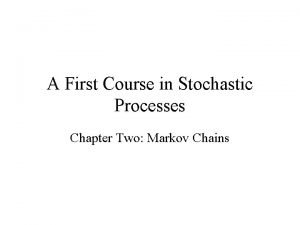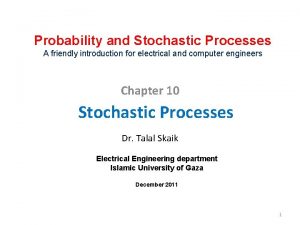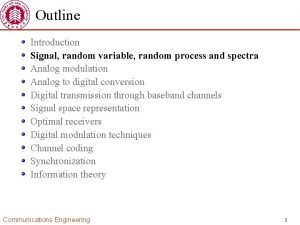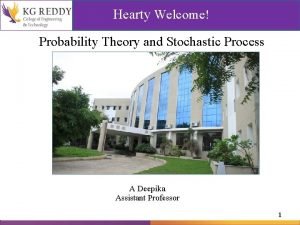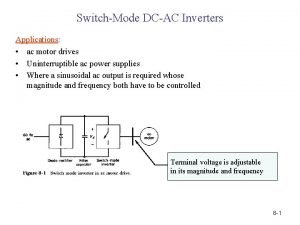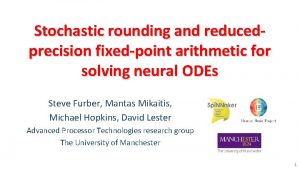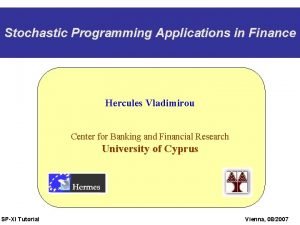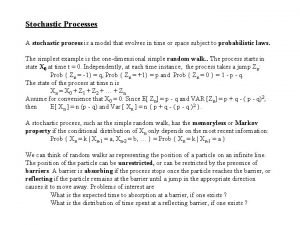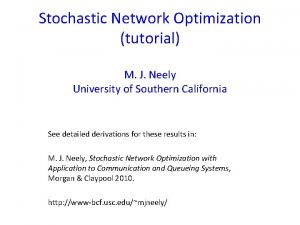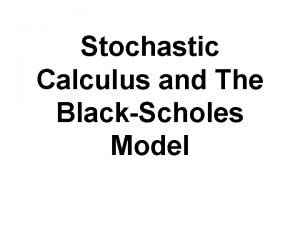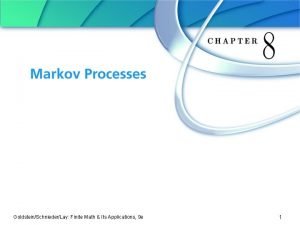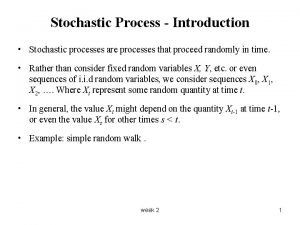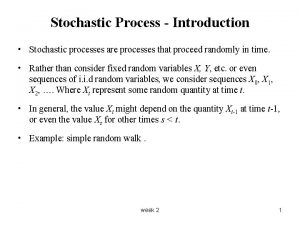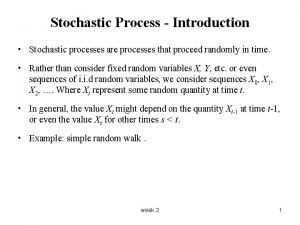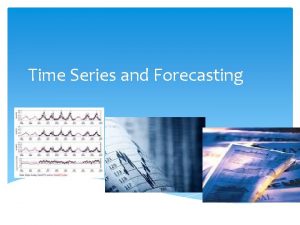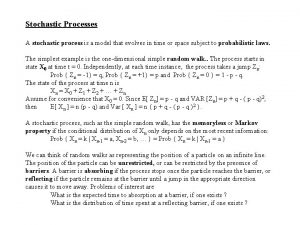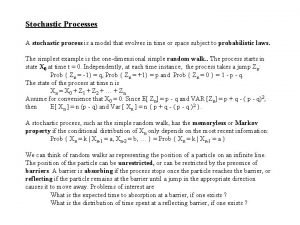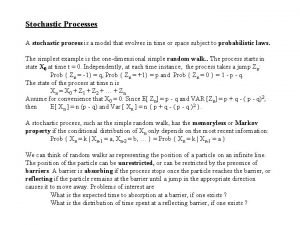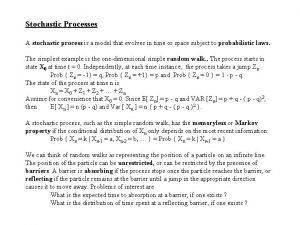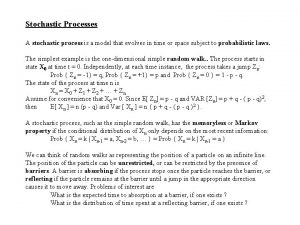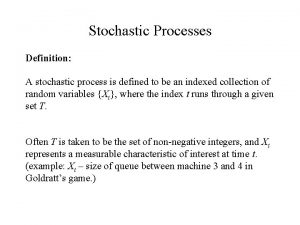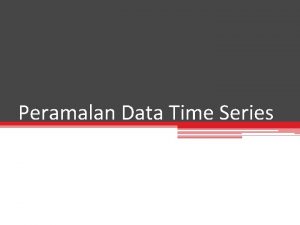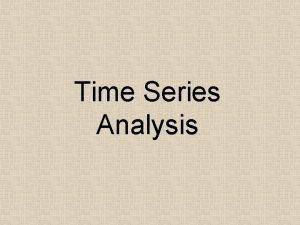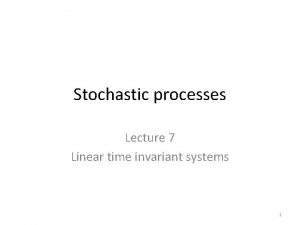Lecture 16 Time Series and Stochastic Processes Thursday


















- Slides: 18

Lecture 16 Time Series and Stochastic Processes Thursday, October 21, 1999 William H. Hsu Department of Computing and Information Sciences, KSU http: //www. cis. ksu. edu/~bhsu Readings: Chapter 16, Russell and Norvig “The Future of Time Series: Learning and Understanding”, Gershenfeld and Weigend CIS 798: Intelligent Systems and Machine Learning Kansas State University Department of Computing and Information Sciences

Lecture Outline • Readings: Chapter 16, Russell and Norvig • Exercise: 16. 1(a), Russell and Norvig (Bring Answers to Class) • Introduction to Time Series – Time series analysis • Forecasting (prediction) • Modeling • Characterization – Probability and time series: stochastic processes – Representations: linear models – Time series understanding and learning • Understanding: state-space reconstruction • Learning: parameter estimation (e. g. , using artificial neural networks) • Next Lecture: Policy Learning, Markov Decision Processes (MDPs) – Read Chapter 17, Russell and Norvig – Read Sections 13. 1 -13. 2, Mitchell CIS 798: Intelligent Systems and Machine Learning Kansas State University Department of Computing and Information Sciences

Time Series Analysis • Problems – Given: observations of a system through time (historical data D) – Forecasting, aka prediction: predict the short-term behavior of system – Modeling: find a description for the long-term behavior of system – Characterization: determine fundamental properties of system with no prior knowledge • Forecasting – Simple (“traditional”): extrapolation (windowing, smoothing) methods – “Modern”: linear models - e. g. , weighted sum of previous observations + noise • Modeling – Fitting model components to capture system behavior (read: finding hypothesis) – Parameter estimation: maximizing P( | D) • Characterization – Example: determining number of degrees of freedom; clusters; randomness – Model selection: sometimes uses such characterization CIS 798: Intelligent Systems and Machine Learning Kansas State University Department of Computing and Information Sciences

Forecasting • Framework – Given: observations D {x(t 0), x(t 1), …, x(tm)} where x(ti) (x 1(ti), x 2(ti), …, xn(ti)) – Predict: a continuation of {x(t)}, e. g. , x(tm+1), x(tm+2), …, x(tm+k) for “small” k – Forecasting : time series analysis : : performance element : learning system • Decision Support Applications – Prognostic monitoring: crises, resource demand, business simulations – Recommender systems: precision agriculture, patent intelligence, logistics – Control automation: damage control, manufacturing, negotiation, web agents • Solution Approaches – Predict with linear model: compute estimated function of previous observations – Bayesian methods: integrate predictions over a hypothesis space H • Role of Learning – Characterizing {x(t)} to choose a hypothesis language (e. g. , type of linear model) – Modeling: acquiring predictive model of {x(t)} – Forecasting: applying predictive model CIS 798: Intelligent Systems and Machine Learning Kansas State University Department of Computing and Information Sciences

Learning to Forecast (Predict) Time Series • Old Solution: Pure Extrapolation – Pure extrapolation: fit a curve through all the points (in time domain) – Use to generate predictions: plug in tm+k as dependent variable • Problems with Old Solution – Doesn’t capture local dependencies (e. g. , periodicities) – Very sensitive to noise; cannot adequately isolate it • New Solutions – Linear models: estimate function over past observations • e. g. , fixed “window”; decaying average of all past observations; both • Use estimate (hypothesis) to generate points of the continuation • Problems with this approach: typically can’t prove system behaves this way – Characterization: understanding the pattern-generating process • Time-delay embedding: change of representation for dynamical system • State-space reconstruction: finding hypotheses in transformed space – Modeling: using this knowledge to guide learning (parameter estimation) CIS 798: Intelligent Systems and Machine Learning Kansas State University Department of Computing and Information Sciences

Modeling • Framework – Given: D {x(t 0), x(t 1), …, x(tm)} – Return: a hypothesis h H such that h(D) predicts {x(tm+1), x(tm+2), …, x(tm+k)} – Compare: classifier learning (return h, use to classify: h(x) = c(x), h(x) = v(x)) • Issues – May need to transform X to X’: e. g. , time domain frequency domain – Just as with classification, probabilistic methods may estimate v. MAP or v. BOC • Solution Approaches – Train artificial neural network (ANN) to map from {x(ti-k), x(ti-k+1), …, x(ti)} to x(ti+1) • Can a static (i. e. , atemporal) feedforward ANN express the relationship? • Can perform change of representation (embedding) using recurrent ANN – Other classifiers: e. g. , Hidden Markov Model (HMM), IBL (e. g. , k-d trees), etc. • Role of Learning – Works in conjunction with characterization (meta-learning) step – Modeling: the core learning step – Performance element: apply (query) to generate predictions, responses CIS 798: Intelligent Systems and Machine Learning Kansas State University Department of Computing and Information Sciences

Learning Models of Time Series • Linear Models – Finite impulse response (FIR) filter: moving average (MA) model – Infinite impulse response (IIR) filter: autoregressive (AR) model • System Identification (SID) – Term for building system models from test data (in this case, dynamical systems) – Many common objectives (and methods) with machine learning • Machine Learning Interpretation – Model types: hypothesis languages aka hypothesis spaces (H) • Focus: linear (stochastic process) models • Exponential trace of initial observations (MA) • Linear combination over window of past observations (AR) – Objective: find a (quantitatively) consistent hypothesis h – Parameter estimation: denotes trainable parameters of h D Model (i. e. , train) v Predict • MAP: maximize P(v | D) P(v, D), i. e. , maximize P(D) · P( | D) · P(v | ) • Bayes optimal: maximize P(v | D) P(v, D) = P(D) · P( | D) · P(v | ) CIS 798: Intelligent Systems and Machine Learning Kansas State University Department of Computing and Information Sciences

Characterization • Framework – Given: observations D – Develop: description of H • Characterization: use this description to select parameters • Modeling: use this description to select parameter values • Direct versus Indirect Characterization – Direct: find transformation of X, H into better-understood X’, H’ – Indirect: train models, study h’s to describe H (“understanding through learning”) • Solution Approaches – Model selection: searching H using probabilistic criteria (e. g. , MDL / BIC) – Direct characterization: state-space reconstruction (by delay-space embedding) – Indirect: post-visualizations of ANN performance; statistical validation; etc. • Role of Learning – Characterization: the meta-learning step – Apply to control learning (modeling) step and produce predictions – NB: may need to implement using clustering (to transform X), wrapper CIS 798: Intelligent Systems and Machine Learning Kansas State University Department of Computing and Information Sciences

Learning Characteristic Descriptions of Time Series • Old Solution Approach: Qualitative – Find ad-hoc characterization that worked well for particular data set – Report it and try to generalize • Problems with Old Solution – No systematic formulation of the meta-learning problem – Not amenable to computational approaches (e. g. , searching for good H) • New Solutions – Discoveries: time series characterization as high-level pattern recognition • How to test whether time series was generated by deterministic linear system • How to characterize noise model and isolate it from the linear system – Concurrent developments in machine learning • How to systematically search for a descriptor of H • How to relate state-space reconstruction to training models (e. g. , ANNs) • Algorithms for implementing delay-space embedding in learning systems – Experimental framework: systematizing the high-level learning problem CIS 798: Intelligent Systems and Machine Learning Kansas State University Department of Computing and Information Sciences

Stochastic Processes • Definition – Stochastic process: family of random variables {x(t)}, parameter t T – Parametric series: t denotes (for example) distance, objects, time elapsed • Stochastic Processes and Time Series – Stochastic process defines behavior of system: x( • ) is an attribute vector – Description of underlying (dynamical) system: by recurrences, linear models, etc. • Learning about Stochastic Processes 0. 6 – Today: linear models 1 2 • Autoregressive moving average (ARMA) family (ARMA, AR, MA) 3 0. 4 • ANN representations A 0. 4 B 0. 6 – Hidden Markov Models (HMMs): can observe outputs, not internal transitions – Next: Markov Decision Processes (MDP, aka Markov Decision Problem) • Problem: calculating policy over stochastic process, given observations • MDP : HMM : : decision network : Bayesian network CIS 798: Intelligent Systems and Machine Learning Kansas State University Department of Computing and Information Sciences

Linear Time Series Models • Linear Models – Moving Average (MA(q)) model aka finite impulse response (FIR) filter • • x(t) = observed stochastic process • e(t) = external signal (e. g. , white Gaussian noise) – Autoregressive (AR(p)) model aka infinite impulse response (IIR) filter • • If e(t) is additive WGN: – Autoregressive moving average (ARMA(p, q)) model • • Combines AR and MA model parameters (can express either or both) • Order of a Linear Model: p, q (e. g. , AR(1)) • Learning Problem: Finding Hyperparameters (p, q), Parameters (ai, bj) CIS 798: Intelligent Systems and Machine Learning Kansas State University Department of Computing and Information Sciences

State-Space Reconstruction • Time Delay Embedding: Change of Representation – Original instance space X: attribute vectors arranged in time • Independent axis: time domain • Dependent axis: x(t) – Time series prediction: instance space X defines original hypothesis space H – New instance space X’: delay-space embedding • Concept from signal processing (convolutional codes) • Express x(t + 1) = a · xp(t) + b · e(t + 1) where xp(t) = (x(t), x(t - 1), …, x(t - p + 1)) • xp(t), a: lag vectors aka tapped delay line • Problem Definition – Given: historical D = {x(t)} – Output: prediction for x(t + 1) by recovering lag vector from D • Solution Approach – State space reconstruction (of X): lag vectors applied to past values of {x(t)} – e. g. , linear combination of xp(t) according to a CIS 798: Intelligent Systems and Machine Learning Kansas State University Department of Computing and Information Sciences

Neural Networks for Time Series Learning • Problem: Acquire Linear Model (Estimate Parameters) • Solution Approach – Models • Simple recurrent networks (SRNs) [Jordan, 1987; Elman, 1990] • Time-delay neural networks (TDNNs, aka tapped delay line neural networks) [Lang, Waibel, and Hinton, 1990] • Gamma memories: [Principe and de. Vries, 1992] – Learning algorithms for temporal ANNs • Backpropagation through time (BPTT) [Rumelhart et al, 1986] • Real-time recurrent learning (RTRL) [Williams and Zipser, 1989] • Subtypes of Simple Recurrent Networks (SRNs) – Input recurrent (IR): input-to-input unit feedback; exponential trace (~MA(1)) – Elman: hidden-to-input unit feedback; no linear model characterization known – Jordan: output-to-input unit feedback; autoregressive (~AR) CIS 798: Intelligent Systems and Machine Learning Kansas State University Department of Computing and Information Sciences

Connectionist Time Series Learning: ARMA Characterization • Implementing Delay-Space Embedding – Lag vector xp(t) can be captured by TDNN – Gamma memory: a low-order ARMA model • Depth versus Resolution – Depth: non-Markovity, i. e. , P(x(t + 1) | xp(t)) P(x(t + 1) | x(t)) – Resolution: representation accuracy at a particular lag (delay) value – TDNNs: high resolution, low depth; IR networks: low resolution, high depth – Gamma memories: high resolution, high depth (and high complexity!) • Forecasting with Temporal ANNs – References • Mozer, 1994; Mehrotra, Mohan, and Ranka, 1997: kernel functions • Haykin, 1994; Hassoun, 1995: BPTT, RTRL • Bishop, 1995: one-step ahead versus multi-step ahead prediction • Hsu, 1998: mixtures of temporal ANNs (SRNs, TDNNs, Gamma memories) – Issue: generating continuations - how useful is it to look further ahead? CIS 798: Intelligent Systems and Machine Learning Kansas State University Department of Computing and Information Sciences

Santa Fe Institute Time Series Learning Competition • Competition – One of first open computing challenges on Internet (1991) – “Only” several megabytes of data (FTP, floppy distribution) – Ran from 8/1/1991 - 1/15/1992; results in book (Gershenfeld and Weigend, 1994) – Objective: to provide benchmark corpus and representative test standard • Web Site: http: //www. stern. nyu. edu/~aweigend/Time-Series/Santa. Fe. html – Several data sets from competition in online archive, for you to try – Research benchmark for time series learning models, algorithms, approaches • Six Data Sets – Laser intensity level (far-infrared) – Sleep apnea patient readings (heart rate, chest volume, blood O 2, EEG rate) – High-frequency currency exchange rate (Swiss franc versus U. S. dollar) – Synthetic dynamical system – Astrophysical data (intensity of white dwarf star; noisy measurements) – J. S. Bach’s last, unfinished fugue from The Art of the Fugue CIS 798: Intelligent Systems and Machine Learning Kansas State University Department of Computing and Information Sciences

Time Series and Policy Learning • Problem Definition – Given • Stochastic environment: outcome P(Result (action) | Do(action), state) • State: totally observable (accessible) or partially observable (inaccessible) – Return: a policy f : state action • Foundations of Policy Learning – Utilities: U: state value – Markov Decision Processes: next • Solution Approaches – Value iteration: utility decomposes according to reward function • Calculate utilities of each state • Use state utilities to select optimal action a, given inferred state – Policy iteration: utility decomposes according reward function, policies • Pick a policy; calculate utilities of each state given the policy • Modify policy to include optimal action, given inferred state CIS 798: Intelligent Systems and Machine Learning Kansas State University Department of Computing and Information Sciences

Terminology • Introduction to Time Series – Time series analysis: forecasting (prediction), modeling, characterization – Stochastic process: series of random variables x(t) with time parameter t • Learning: Acquiring Models of Time Series – Linear models – Autoregressive moving average (ARMA) models: AR, MA – ANN approximation • Simple recurrent networks (SRN): Elman, Jordan (AR), input recurrent (MA(1) aka exponential trace: high resolution, low depth) • Time-delay neural networks (TDNN): AR; low resolution, high depth • Gamma memories: ARMA; high resolution and depth (more difficult to train) – Time series understanding and learning • State-space reconstruction: recovering lag vector from D, predicting x(t + 1) • Parameter estimation problem for ARMA models CIS 798: Intelligent Systems and Machine Learning Kansas State University Department of Computing and Information Sciences

Summary Points • Introduction to Time Series – 3 phases of analysis: forecasting (prediction), modeling, characterization – Probability and time series: stochastic processes – Linear models: ARMA models, approximation with temporal ANNs – Time series understanding and learning • Understanding: state-space reconstruction by delay-space embedding • Learning: parameter estimation (e. g. , using temporal ANNs) • Further Reading – Analysis: Box et al, 1994; Chatfield, 1996; Kantz and Schreiber, 1997 – Learning: Gershenfeld and Weigend, 1994 – Reinforcement learning: next… • Next Lecture: Policy Learning, Markov Decision Processes (MDPs) – Read Chapter 17, Russell and Norvig, Sections 13. 1 -13. 2, Mitchell – Exercise: 16. 1(a), Russell and Norvig (bring answers to class; don’t peek!) CIS 798: Intelligent Systems and Machine Learning Kansas State University Department of Computing and Information Sciences
 A first course in stochastic processes
A first course in stochastic processes Introduction to stochastic processes pdf
Introduction to stochastic processes pdf Stochastic process
Stochastic process Dn0jx
Dn0jx Concurrent processes are processes that
Concurrent processes are processes that 01:640:244 lecture notes - lecture 15: plat, idah, farad
01:640:244 lecture notes - lecture 15: plat, idah, farad Inventory modeling
Inventory modeling Deterministic and stochastic inventory models
Deterministic and stochastic inventory models Geology lecture series
Geology lecture series Dcac lecture series
Dcac lecture series Start time end time and elapsed time
Start time end time and elapsed time Series aiding and series opposing
Series aiding and series opposing Stochastic rounding
Stochastic rounding Stochastic programming
Stochastic programming Asynchronnous
Asynchronnous Stochastic optimization tutorial
Stochastic optimization tutorial Put call formula
Put call formula Stochastic vs dynamic
Stochastic vs dynamic Stochastic matrix
Stochastic matrix
